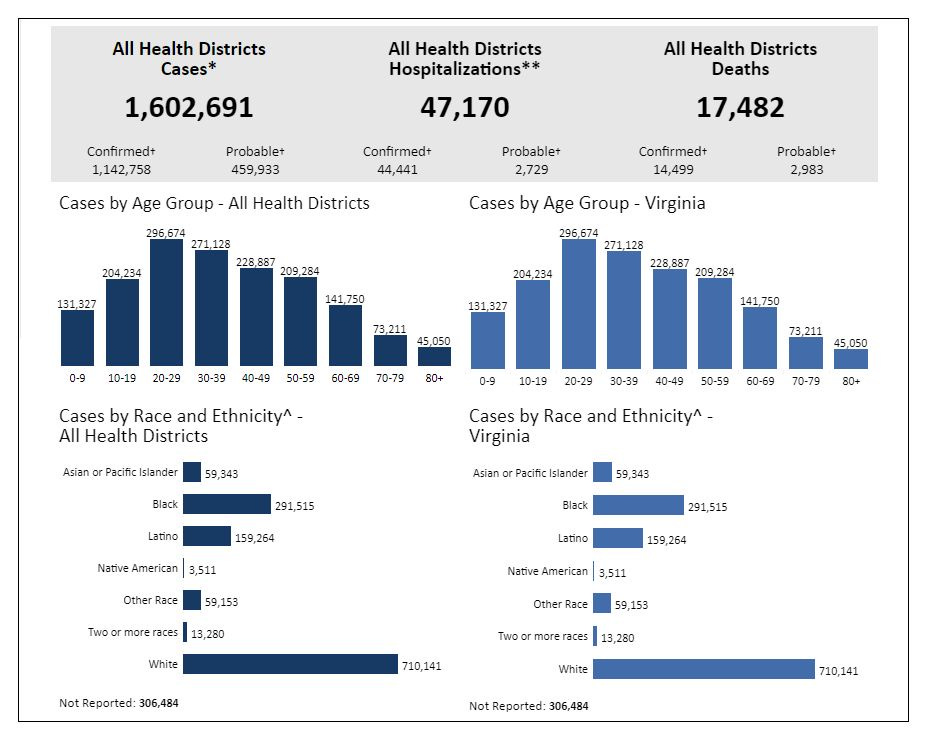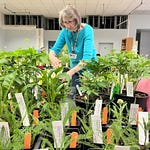With each passing day, there’s a little more light at the beginning and end of the period in which the sun illuminates our portion of the world. There are 36 days until the time when light and dark is more or less equal. What will happen between now and then? Charlottesville Community Engagement aims to tell you as much as possible. I’m your host, Sean Tubbs.
On today’s program:
Legislation to make mask mandates meaningless in schools is poised to pass the Virginia General Assembly
Albemarle County is briefed on the potential threat of the Spotted Lanternfly
Charlottesville City Council is briefed on how floodplains are classified, and then votes to approve a rezoning on Nassau Street to allow more residential density
And Charlottesville Economic Development continues tracking retail vacancies across the city
Shout-out to Camp Albemarle
Today’s first subscriber-supported public service announcement goes out to Camp Albemarle, which has for sixty years been a “wholesome rural, rustic and restful site for youth activities, church groups, civic events and occasional private programs.”
Located on 14 acres on the banks of the Moorman’s River near Free Union, Camp Albemarle continues as a legacy of being a Civilian Conservation Corps project that sought to promote the importance of rural activities. Camp Albemarle seeks support for a plan to winterize the Hamner Lodge, a structure built in 1941 by the CCC and used by every 4th and 5th grade student in Charlottesville and Albemarle for the study of ecology for over 20 years. If this campaign is successful, Camp Albemarle could operate year-round. Consider your support by visiting http://campalbemarleva.org/donate.
Pandemic update
As the weekend begins, the waning continues. Yesterday the Virginia Department of Health reported a percent positivity of 13.7 percent, down from 23.2 percent eight days earlier. On January 11, that figure was 36 percent.
“We are now in a period of time where we are seeing the highest cases of COVID beginning to come down,” said Dr. Kyle Enfield of the University of Virginia Health System. “And these are the highest cases we’ve ever seen, including among our children. And unfortunately some of these children have had long term outcomes that have been related to COVID as well as deaths.”
In Virginia, there have been eight deaths in people under the age of 10, and 10 deaths of people under the age of 20. There have been 131,327 reported COVID cases in people under the age of 10, and 204,234 under the age of 20.
“And we do know that masking and vaccines have been our best defense at preventing more spread of COVID during all of the pandemic,” Dr. Enfield said.
This week, the Virginia Senate passed a bill on a 21-17 vote that would prohibit localities from requiring students to wear a mask in school. The same bill (SB739) was reported out of the House Education Committee on Friday on a 12 to 10 vote. Here’s what it says:
“The parent of any child enrolled in a public elementary or secondary school, or in any school-based early childhood care and education program, may elect for such child to not wear a mask while on school property,” reads the bill.
Dr. Enfield said that may be premature from a public health perspective.
“While I’m very hopeful for a future where we can stop wearing masks as part of our daily lives, I don’t think the time is there yet,” Dr. Enfield said.
People who are not vaccinated contract COVID at a rate 4.6 percent more than those who have had their shots, according to the latest data from the Virginia Department of Health. Partially vaccinated people contract at a rate two times higher.
Those trends show up close to home, too.
“The most salient thing I think people should take away is that the people that we see in the [intensive care unit] right now, which is about a third of our cases, only one of them was vaccinated and boosted and that person is immunocompromised,” Dr. Enfield said. “I think that speaks to the importance of vaccinations ongoing in preventing serious illness.”
Visit the Blue Ridge Health District’s website for information about getting vaccinated.
Charlottesville vacancy study
The city of Charlottesville has completed its latest analysis of commercial property and has found a vacancy rate of 5.23 percent. That’s up slightly from July when the last report from the Charlottesville Office of Economic Development was compiled.
“The retail property in the City of Charlottesville is showing slight signs of rebounding from the negative impacts felt since the beginning of the COVID-19 pandemic, “ reads the report.
Barracks Road Shopping Center has a vacancy rate of 9.3 percent and the Downtown Mall has increased to 3.7 percent since July. The Corner is at 3.28 percent, Seminole Square is at 12.96 percent. Both Preston Plaza and McIntire Place are both full.
The peak vacancy of 9 percent on the Downtown Mall was recorded in July 2009 and January 2010 at the height of the last recession. Notable vacancies include the spaces that formerly housed Bashir’s Taverna and Fellini’s.
Since the last study last summer, new stores on the way include a new location for Bebedero in the former Downtown Grille space. A restaurant called Botanical Fare will occupy the former Java Java space. Read the report for more details.

Nassau Street rezoning yields four additional units
Charlottesville City Council has taken action on a rezoning on the eastern edge of Belmont, six weeks after asking for more information. The previous Council had held a public hearing for a request to increase the zoning from R2 to R3 on property that some claimed was unsafe for development. They wanted more information about the property’s relationship with the floodplain.
(See also: Council seeks floodplain info before Nassau Street rezoning, December 22, 2021)
On February 7, City Engineer Jack Dawson prepared a briefing for the five elected officials, including two members who just joined.
“There was a fair bit of community members who expressed concern over the flood risk associated with the rezoning including some varying information about floodplain mapping and some other resources about water surface elevation for the one percent annual exceedance event,” Dawson said.
One percent annual exceedance is another way of saying 100-year flood, a term that can be somewhat misleading because such heavy volumes do in fact happen more frequently. Properties that are prone to flooding can still receive insurance through a program monitored by the Federal Emergency Management Agency [FEMA]
“The city agreed to partner with FEMA as floodplain managers when we signed on to the National Flood Insurance Program,” Dawson said. “City property owners get access to insurance through the NFIP exchange and in return we agreed to create a floodplain development ordinance with a series of minimum standards.”
The property on Nassau Street is within the one percent exceedance zone, colored light blue on the city’s GIS viewer. That’s different from the floodway which is marked with red and blue stripes.
FEMA officials determine where those boundaries lie and make periodic reviews, but property owners can appeal based on evidence. This is a process known as the Letter of Map Revision, or LOMR.
“The city is the gatekeeper for determining LOMR validity,” Dawson said. “A LOMR should improve or correct the existing model or improved methods. It’s our job in engineering as the floodplain administrators to make sure it is technically sound.”
An application for this property was made to FEMA in October 2014 and sent it on for the city for their comments. However, Dawson said in this case, the technical comments from engineering were not captured in the revision.
“The 2017 LOMR. whether or not engineering agreed with it at the time, is the model that informs the flood plain,” Dawson said.
He also said that engineering doesn’t usually get involved during a rezoning.
“But when a site plan is submitted, we look to make sure it meets all codes and they can be in the flood plain as long as they’re built one foot above the flood elevation,” Dawson said.
Dawson said there is a risk in building in the floodplain, and many have done so. There are 266 lots that have structures are in the floodplain.
“It’s a high risk area,” Dawson said. “Living there, there’s some implicit risk with that and more people living in the flood plain means there’s more risk taken on as a city.”
Charlottesville Mayor Lloyd Snook said he had had concerns about the process after they were brought up. But, he said he arrived at a conclusion after many conversations.
“The decision that we are being asked by some folks to make here is not a proper decision for us to make at the rezoning phase,” Snook said. “That does not mean that that if we grant the rezoning that it’s necessarily going to pass the site plan review.”
Developer Nicole Scro said that by-right, they would build three duplexes on the property. The rezoning would allow more units to be built, which would bring down the cost of each to the people who will live there.
“The composition of the units is smaller units and we’re doing that to save on construction costs so we can hit lower rents,” Scro said. “That’s the purpose of this rezoning.”
Scro said she understood the concerns, but said she felt confident about the flood risk. The structures will be built at 327 feet above sea level.
“And then we’re going to have three feet of crawl-space and another foot of subflooring so the finished floor elevation will be at 331 approximately,” Scro said.
Council voted 5-0 to agree to the rezoning.
This isn’t the end of the story with flood modeling.
Charlottesville is beginning to develop a new flood model for the Moores Creek watershed to better understand hydrological processes. This is being paid for by the state government with proceeds from the Regional Greenhouse Gas Initiative.
See also: Charlottesville awarded $153K for flood study from RGGI funds, October 6, 2021
Shout-out for an upcoming talk on birds
In today’s subscriber-fueled shout-out, if you’re interested in learning more about the birds around us, the National Sporting Library and Museum has a virtual event for you coming up on February 24. Jennifer Ackerman, the author of the Genius of Birds, will explore the brilliance of birds and delve into the mysteries of the avian brain. Ackerman as she shares her global adventures into the genius of birds. Learn how birds make and use tools, teach each other skills, count, navigate, create art, perform astonishing feats of memory, communicate, and even pass along cultural traditions.
The author will be joined by two top officials from the Wildlife Center of Virginia, an organization that has helped nearly 90,000 wild animals from every corner of Virginia. Center President Ed Clark and Senior Vice President Amanda Nicholson will bring along Ambassador Animals. The program is free and available via Zoom or Facebook like. Drop a line to info@nationalsporting.org for a link, or visit the National Sporting Library and Museum on Facebook.
Albemarle briefed on spotted lanternfly
As program manager for Plant Industry Services at the Virginia Department of Agriculture and Consumer Services, David Gianino leads the state’s efforts to fight threats to native plants that could harm whole industries if left unchecked.
“And we have many different pest programs where we work with invasive species to mitigate either their spread or their impact here in Virginia, and in 2021 unfortunately Spotted Lanternfly has made its way to Albemarle County,” Gianino said.
That was in July 2021 when a plant inspector found multiple life-stages along the Rivanna River near a railroad.
Gianino told the Albemarle Board of Supervisors on February 2 that the Spotted Lanternfly can severely damage apples and grapes.
“It is a piercing, sucking, mouth-part insect and it sucks phloem and sap from the stems of these trees which can negatively impact yield and can impact the quality of a fruit that relies on lots of sugar content,” Gianino said. “They swarm and feed very intensely in the fall and that can also impact how nice the grapes are, how good a wine it makes.”

The spread of Spotted Lanternfly is due to it being a hitchhiking bug that jumps onto modes of transportation. Originally from China, the bug arrived in Pennsylvania in 2014.
“It doesn’t traditionally fly but it will glide and it jumps on to cars, trucks, gravel, buses, anything that moves it will jump onto and that’s the primary way it gets around,’ Gianino said.
Gianino said the swarms can also affect other property owners because it is unpleasant to be around. He said if not addressed, this can affect agribusiness and especially agritourism.
“The sheer number of insects that pest can create in an environment is astounding,” Gianino said.
The spread of the spotted lanternfly is compounded by another invasive species known either as alanthus or Tree of Heaven.
So far, populations in Albemarle County are not as high as they are in the Winchester area, where a quarantine was established in 2019 and expanded to Clark and Warren counties last summer.
“The quarantine requires business owners to obtain a permit and inspect all materials that are stored outside as well as trucks, trailers and vehicles that travel outside of the quarantine area,” reads a site set up to provide information for Winchester area residents.
“I believe we have opportunities here to prevent this from happening [in Albemarle] because we do now have better tools,” Gianino said.
Gianino said the site in Albemarle was treated with pesticides. Trees were injected with substances to prevent further infestation.
“We’ve placed traps, we’ve scraped egg masses, and we plan to do a thorough survey there next year and continue treatment to try and mitigate this population,” Gianino said.
There are no natural predators here and Gianino said they do not taste very good to other species.
Gianino said early detection is key to addressing any invasive species and people who make a sighting are asked to report it to local extension offices so the extent of the spread is known across the Commonwealth. They also want people to seek out resources:
Also, kill it.
“We tell people to stomp, scrape, squish the spotted lanternfly and then report it,” Gianino said.
More on this as we move toward spring.

Support the program!
Special announcement of a continuing promo with Ting! Are you interested in fast internet? Visit this site and enter your address to see if you can get service through Ting. If you decide to proceed to make the switch, you’ll get:
Free installation
Second month of Ting service for free
A $75 gift card to the Downtown Mall
Additionally, Ting will match your Substack subscription to support Town Crier Productions, the company that produces this newsletter and other community offerings. So, your $5 a month subscription yields $5 for TCP. Your $50 a year subscription yields $50 for TCP! The same goes for a $200 a year subscription! All goes to cover the costs of getting this newsletter out as often as possible. Learn more here!



















Share this post